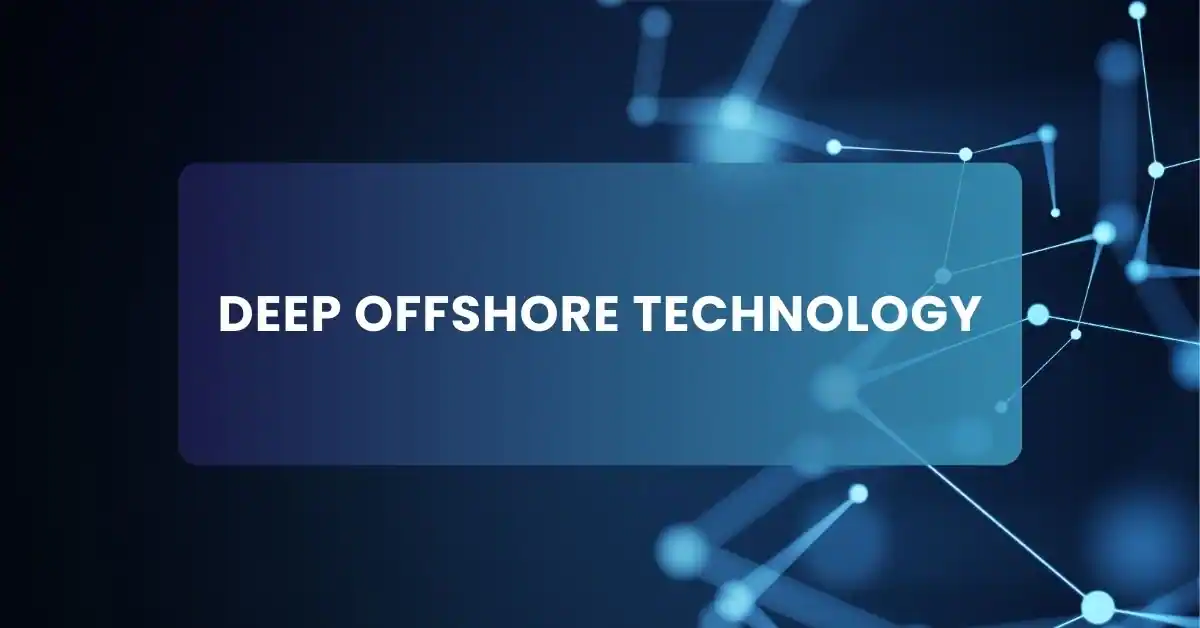Deep offshore technology represents a suite of advanced tools, techniques, and innovations designed to enable exploration, drilling, and production of resources in ocean depths beyond 300 meters. As global demand for oil, gas, and renewable resources continues to surge, industries are increasingly pushed to explore these challenging environments. Consequently, deep offshore technology has become essential, allowing companies to tap into resources that were once considered unreachable.
Table of Contents
ToggleWhy Deep Offshore Technology is Essential in Modern Industries
In today’s world, deep offshore technology is not just an advancement; rather, it has become a necessity. This technology ensures safe and sustainable operations in some of the harshest and most remote environments on the planet. With each technological leap forward, the industry gains the ability to access areas previously considered impossible to reach. Ultimately, these advancements are essential for meeting the world’s rising resource and energy demands.
The Evolution of Offshore Drilling Technology
Over the years, offshore drilling has evolved significantly, shifting from shallow-water platforms to complex deep-sea operations. Initially, oil rigs were limited to nearshore locations, but as technology advanced, the industry moved further and deeper into the ocean. Today’s modern rigs, equipped with automation and advanced safety features, make deep-sea drilling not only viable but also environmentally considerate, thanks to these innovations.
Key Applications of Deep Offshore Technology
When considering the scope of deep offshore technology, it’s clear that it has diverse applications. These include energy exploration, marine biology research, and renewable energy projects, such as offshore wind farms. While oil and gas exploration are primary applications, the technology also plays a crucial role in carbon capture and storage (CCS) and environmental monitoring, thus expanding its impact across various industries.
Types of Deep Offshore Technology
1. Subsea Production Systems
To begin with, subsea production systems are essential for deep offshore operations. These systems involve specialized equipment placed directly on the ocean floor, enabling efficient extraction and transportation of resources. Designed to withstand extreme pressures and temperatures, these systems consist of various components like manifolds, templates, and flowlines that streamline operations at ultra-deep depths.
2. Drilling Rigs and Platforms
Another key component of deep offshore technology is the use of drilling rigs and platforms. Depending on the specific site requirements and water depth, different types of rigs, such as drillships and semi-submersible rigs, are used. Notably, these rigs are capable of operating in waters beyond 10,000 feet deep. Equipped with advanced safety features, they are built to withstand the harsh conditions of marine environments, ensuring durability and reliability.
3. Remote Monitoring and Control Systems
In addition to physical infrastructure, modern deep offshore platforms depend heavily on remote monitoring and control systems. These systems allow for real-time data collection and analysis from onshore control centers, helping to monitor well pressure, environmental conditions, and equipment health. As a result, remote monitoring significantly reduces the need for human presence in hazardous areas, enhancing both safety and operational efficiency.
Advanced Techniques in Deep Offshore Drilling
1. Dynamic Positioning Systems
One major advancement in deep offshore technology is the use of dynamic positioning systems. These systems allow rigs to maintain precise positioning over the seabed without the need for physical anchors. By utilizing GPS and thrusters, they effectively counteract ocean currents and winds, providing the stability and safety required during deep-sea operations.
2. Riserless Drilling
Another notable technique is riserless drilling, which eliminates the need for a riser pipe to connect the drilling rig to the seabed. This approach is particularly beneficial in ultra-deep waters, where traditional riser systems may be impractical or cost-prohibitive. Therefore, riserless drilling has become an innovative solution, enabling companies to explore in even the most challenging environments.
3. Subsea Compression and Separation
Additionally, subsea compression and separation allow for gas compression and separation processes to occur directly on the ocean floor. By processing resources at the seabed, this technique reduces the need for surface-level processing, which not only enhances efficiency but also lowers the environmental risks associated with deep-sea extraction.
Challenges in Deep Offshore Technology
Environmental Concerns and Sustainability
Despite the significant benefits, deep offshore operations face numerous environmental challenges. For instance, potential oil spills, habitat disruption, and waste management issues are major concerns. To address these challenges, companies are actively working on implementing cleaner technologies and sustainable waste-handling practices, which minimize the ecological impact and promote responsible extraction.
Safety Risks and Mitigations
Moreover, safety remains a top priority due to the volatile nature of deep offshore environments. Equipment failure, rig collapses, and high-pressure conditions present constant risks. Consequently, companies invest heavily in advanced safety protocols, emergency response systems, and redundant equipment to mitigate these risks. By focusing on safety, they ensure that operations can continue smoothly even under challenging conditions.
Innovations Shaping the Future of Deep Offshore Technology
1. Robotics and AI Integration
In recent years, robotics and artificial intelligence (AI) have transformed deep offshore operations, enhancing safety and efficiency. Robots, for example, perform tasks in hazardous areas, reducing the risk to human operators. Similarly, AI-driven systems analyze vast datasets, assisting in predictive maintenance and optimizing drilling operations. By enabling data-driven decision-making, AI enhances both productivity and safety.
2. Autonomous Underwater Vehicles (AUVs)
Another groundbreaking innovation is the use of Autonomous Underwater Vehicles (AUVs). Designed to operate autonomously, AUVs handle tasks such as seabed mapping, pipeline inspection, and data collection. Operating in environments too risky for human intervention, AUVs improve efficiency and reduce operational risks, proving essential in offshore applications.
3. Digital Twins and Data Analytics
Additionally, digital twins—virtual replicas of physical offshore assets—are becoming increasingly popular. These models allow for real-time monitoring and predictive maintenance, providing a virtual testing ground for various scenarios. As a result, companies can optimize processes, prevent equipment breakdowns, and ultimately save costs, all while enhancing safety.
Conclusion
In conclusion, deep offshore technology has become an indispensable component of modern energy and marine industries. By facilitating exploration and extraction in some of the world’s most challenging environments, this technology meets global energy demands while advancing sustainable practices. With ongoing technological progress and a growing commitment to environmental responsibility, deep offshore technology will continue to evolve. It not only fulfills current needs but also paves the way for the discovery of the ocean’s untapped potential.
Frequently Asked Questions
1. What is deep offshore technology used for?
Deep offshore technology is primarily used for oil and gas extraction from deep-sea locations. However, it also supports marine research, environmental monitoring, and renewable energy projects, making it highly versatile.
2. How deep can offshore drilling go?
Currently, offshore drilling can reach depths of over 10,000 feet. Thanks to technological advancements, exploration in ultra-deep waters beyond this threshold is increasingly feasible.
3. What are the environmental impacts of deep offshore technology?
Environmental impacts may include oil spills, habitat disruption, and pollution. However, companies are adopting cleaner technologies and sustainable practices to minimize these effects, promoting responsible extraction.
4. How is AI used in deep offshore technology?
AI is utilized in data analysis, predictive maintenance, and automated operations, all of which help improve safety, optimize drilling processes, and reduce human involvement in risky environments.
5. What are digital twins in offshore technology?
Digital twins are virtual models of physical assets that allow for real-time monitoring and testing of offshore equipment. These replicas help operators improve efficiency, anticipate maintenance needs, and enhance overall operational safety.






